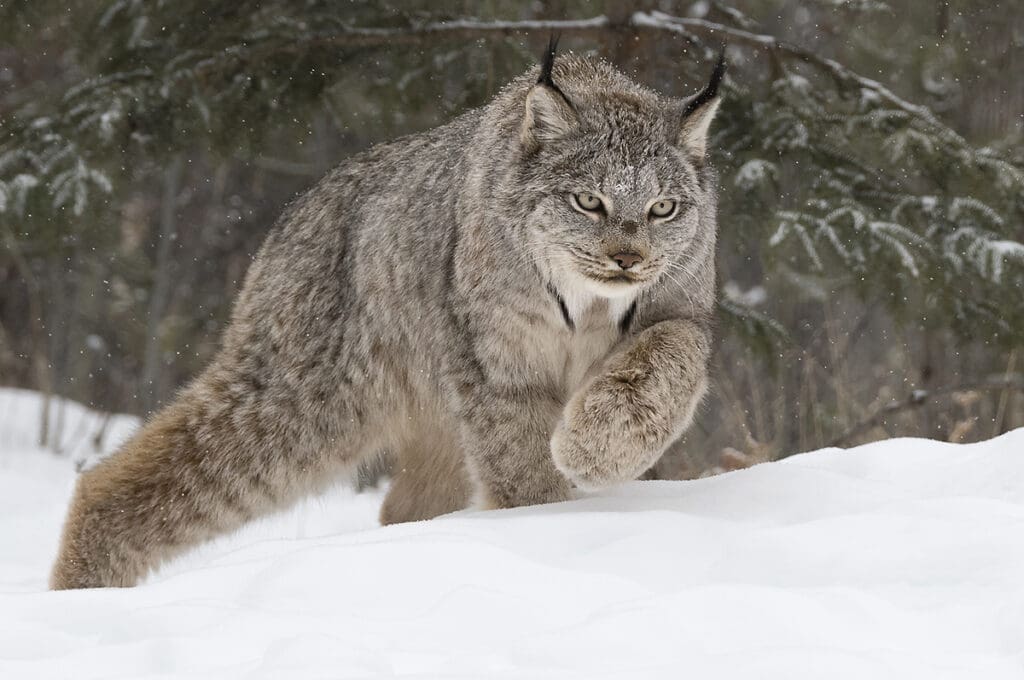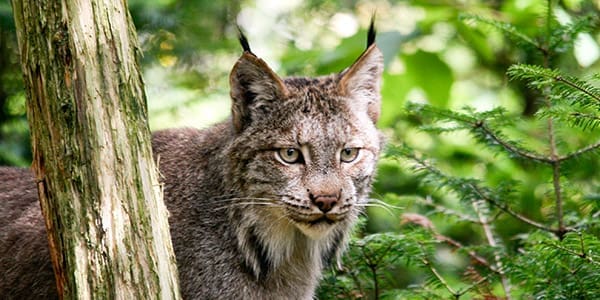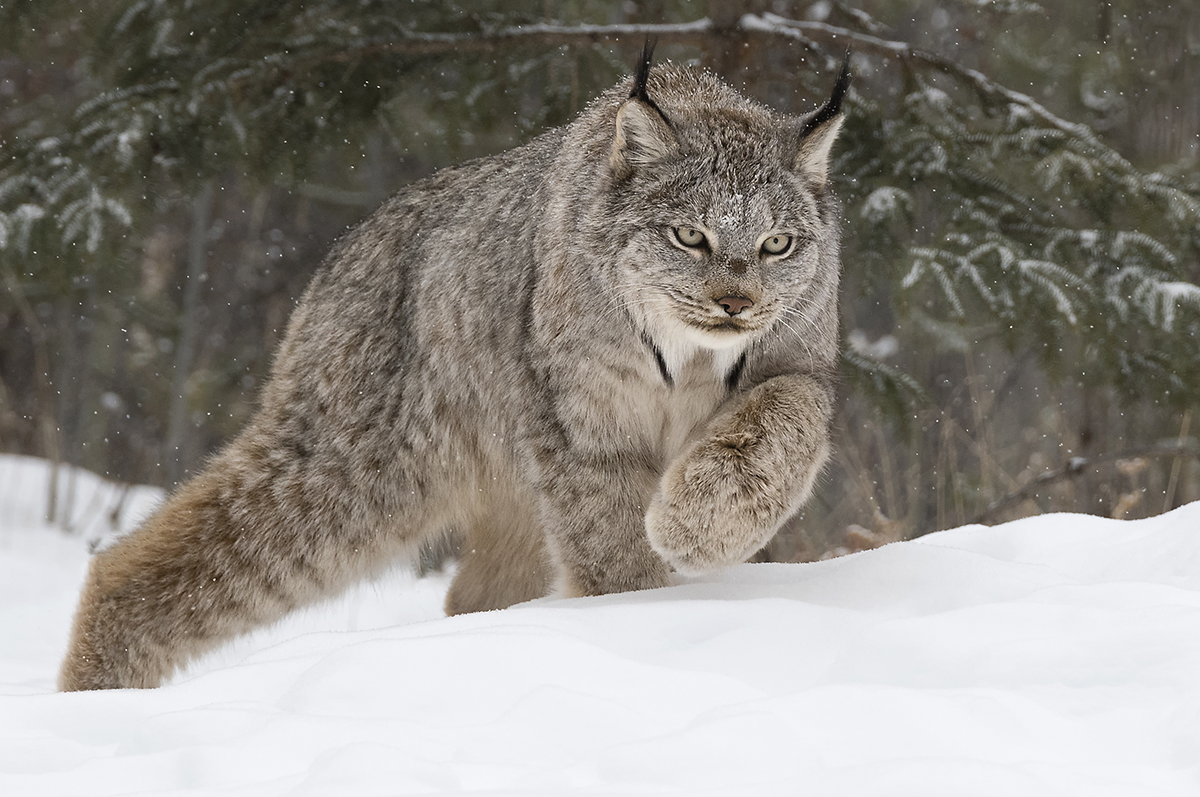What furry feline has stealthy skills, built-in snow gear, and a surprising screech?
The Canada lynx!

The Canada lynx, also known as Lynx canadensis or the Inuktut name of ᐱᖅᑐᖅᓯᕋᖅ (‘piqtuqsiraq’), is a charismatic mammal of the Northernmost parts of North America. This furry, fierce cousin of the bobcat can be found in Canada, of course, as well as Alaska and in some parts of Northern Maine.
This forest feline may resemble a larger version of a housecat, but its predatory prowess is nothing short of formidable. With a heavy coat of fur, including distinctive tufts at its ears and a short, black-tipped tail, large paws that help navigate snowy terrain, and excellent vision and hearing, the Canada lynx is extremely well adapted to its environment.

Prime Predator
In terms of physical attributes and behavior, the Canada lynx possesses exceptional senses, including large eyes and acute hearing, making it an adept nocturnal hunter. In fact, they are able to detect prey in the darkness from as far as 250 feet (76 m) away.
Although not known for speed, these stealthy predators rely on their knack for stealth. They often lie in wait, concealed in strategic hiding spots, before making a calculated pounce on unsuspecting prey. Patiently biding their time for hours on end is not uncommon in their pursuit of sustenance.
Exhibiting a very specific carnivorous diet, these lynxes primarily subsist on snowshoe hares, and fluctuations in hare populations directly correlate with the rise and fall of lynx numbers. When it is available, a single lynx might consume an entire hare for a meal, storing remnants for later consumption. In the absence of hares, they resort to hunting small mammals, birds, and occasionally larger prey such as caribou.

Suited to the snow
Characterized by a compact body, diminutive tail, and elongated legs, the Canada lynx sports a dense, lengthy, and gray fur coat during winter, while transitioning to a shorter, lighter brown coat in summer. Their facial appearance appears broad due to elongated fur patches extending from their cheeks that can give the appearance of a two-pronged beard. They also sport distinctive black-tipped, bobbed tails and elongated tufts on their triangular ears.
Closely resembling the southern-dwelling bobcat, the key difference lies in their tails— the Canada lynx boasts completely black-tipped tails compared to the bobcat’s tail that features a white ring below the black tip. Moreover, the lynx’s sizable, heavily furred paws act as natural snowshoes, with a high surface area to support their movement over deep snow, aiding their mobility during winter hunts.
Residing across forested regions spanning Canada, Alaska, and certain parts of the contiguous United States, Canada lynxes prefer making dens under fallen trees, tree stumps, rock formations, or dense vegetation. These territorial animals are mostly solitary, particularly with male lynxes leading an almost entirely solitary existence.

However, young lynxes stay in the care of their mothers for about a year, and some females have been observed living and hunting in pairs, raising questions for scientists about the social behavior of these big cats. Recently, a team of researchers has begun delving into the social lives of lynxes by tracking their vocalizations. And whether or not you are engaged in studying lynx populations, it’s well worth checking out the haunting sounds of the lynx call:
Big Cats of the Boreal
The Canada lynx, a native denizen of the expansive Boreal Forest, relies heavily on this vast and biodiverse habitat for survival. The boreal ecosystem, characterized by its dense forests of coniferous trees, provides the ideal cover and sustenance for these elusive predators. The lynx thrives amidst the rich tapestry of dense vegetation, fallen trees, and rocky outcrops, creating a mosaic of hiding spots and denning sites crucial for their survival. However, threats to the Boreal Forest, including deforestation, habitat fragmentation, and climate change, pose significant risks to the Canada lynx population.
Deforestation for logging, mining, and human settlement disrupts the lynx’s habitat, diminishing their hunting grounds and safe havens. Fragmentation of the forest reduces connectivity between lynx populations, affecting genetic diversity and hindering their ability to roam and find suitable mates. Climate change exacerbates these issues, altering the boreal ecosystem and impacting prey availability, which is pivotal for the lynx’s sustenance. The cumulative effect of these threats imperils the Canada lynx, highlighting the urgent need for conservation efforts to safeguard both the lynx and its vital habitat in the Boreal Forest, which in turn plays an essential role regulating the carbon and water cycles and overall stability of our climate.
The Canada lynx is more than just an example of might and physical prowess in nature. A true embodiment of the northern forests, these elusive creatures and their unique lifestyle are treasures of the wild. Let us work for ecological integrity in all forests and ecosystems, Boreal and beyond.
For my fellow cat lovers,
Maya

Maya Dutta is an environmental advocate and ecosystem restorer working to spread understanding on the key role of biodiversity in shaping the climate and the water, carbon, nutrient and energy cycles we rely on. She is passionate about climate change adaptation and mitigation and the ways that community-led ecosystem restoration can fight global climate change while improving the livelihood and equity of human communities. Having grown up in New York City and lived in cities all her life, Maya is interested in creating more natural infrastructure, biodiversity, and access to nature and ecological connection in urban areas.
Sources and Further Reading:
https://canadiangeographic.ca/articles/animal-facts-canada-lynx/
https://racinezoo.org/canada-lynx-fact-sheet
https://www.nwf.org/Educational-Resources/Wildlife-Guide/Mammals/Canada-Lynx
https://www.nrcm.org/nrcm-creature-feature/canada-lynx/
https://www.nationalgeographic.co.uk/animals/2020/07/lynx-take-epic-2000-mile-treks-but-why-is-a-mystery
https://defenders.org/blog/2020/09/link-between-lynx-and-national-forests
https://theconversation.com/we-eavesdropped-on-some-canadian-lynx-what-we-heard-was-surprising-161539



